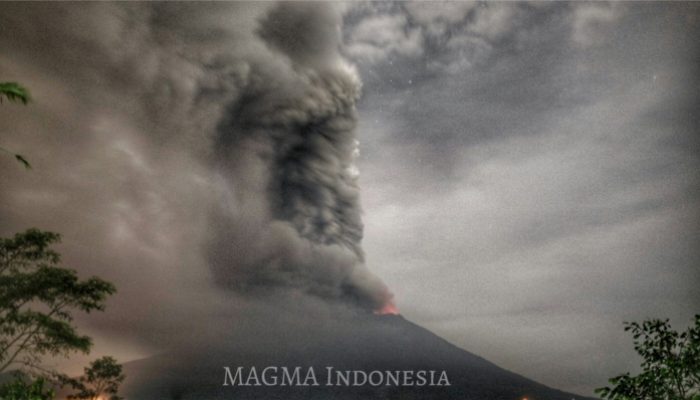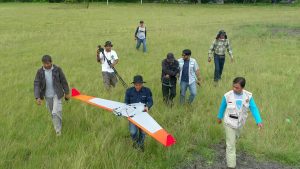
Since our last blog, Agung has had two months to reflect and has recently begun a strong ash venting process, with incandescence visible at night in the summit. Updates from Magma Indonesia, the official communications hub for natural hazards in Indonesia, have highlighted an elevated level of volcanic tremor and an evacuation zone to 12 km radius around the volcano is being enforced. You can follow Magma Indonesia on twitter, and see regular updates on Agung. To the frustration of anyone wishing to fly in or out of Bali, the ash emissions are heading southwest, towards Bali airport, and so the Indonesian authorities have closed the airport as a preventative measure.On 29th November this restriction was lifted as the prevailing wind was no longer transporting ash towards the airport.
The ash plume is rising to only to 3 km above Agung, which is 6 km above sea level. This is the height where jet aircraft are climbing to cruising altitude with a full fuel load, and so are particularly vulnerable to engine failure due to ash ingestion. There is a possibility to take a ferry to Lombok and fly from there. Rinjani volcano on Lombok erupted last year, resulting in a closure to airspace, but fortunately Rinjani seems to be quiet now. There have been reports of people refusing to leave the evacuated area around Agung. It is always best to follow the instructions of the local authorities during an eruption. The Indonesian volcano evacuations have been very successful in recent years with many thousands saved in a series of timely evacuations from Merapi during its eruption in 2010.

Ash from the Agung eruption is collected by the Indonesian volcano monitoring authorities. Image from Magma Indonesia.
The pattern of activity we have seen to date allows for a direct comparison with that observed during the first days of the 1963 eruption, as reported by Self and Rampino [2012]. Then, there were two days of felt seismic activity followed by explosive activity, associated with a lava emission which eventually produced a 7.5 km long lava flow (after 26 days). The explosive activity produced ash and incandescent material that was ejected to 6 km above the craters. Pyroclastic flows, generated either from the collapsing front of the lava flows or the explosive activity, were visible running down canyons on the north and south flanks. After nearly a month of this activity the eruption ramped up to a significant explosion, generating a plume to 19-26 km altitude above sea level. A further tall eruption column was formed during an explosion ~2 months later, and then mild explosions and lahars continued for several months, before the eruption ended.
Comparing with the current activity, it appears that the 1963 eruption was a lot more energetic in its onset. The incandescent ash venting for some days now has not yet led to a more explosive phase and there is no sign yet of a lava flow. However, the transition could be such that pyroclastic flows appear with little to no warning, hence we must stress the importance of adhering to the evacuation procedures. However, this could change quickly, and the transition could be such that pyroclastic flows appear with insufficient time to escape for anyone within the evacuation zone. How the eruption will develop from here is hard to judge. The most likely evolution would be towards a lava effusion as in 1963, but there could be a sudden transition to explosive activity or, whilst lower probability, cessation of activity.
While the activity is very disruptive for local populations and the economy of Bali due to the impact on tourism of airspace closures, this does afford volcanologists with the opportunity to use the new modern techniques to track the eruption and hopefully gain a better insight into the processes which drive the activity. In this way we will progress towards a better understanding of the relationship between the signals that the volcano produces and the imminent activity, allowing better eruption forecasts. We will update this blog as the eruption evolves.

Novel plume monitoring techniques are being employed by Magma Indonesia.
Blog written by Mike Burton, GMPV President (gmpv@egu.eu), and the GMPV science officer team.

Mason Metcalfe
When forecasting a volcanic eruption, how do Indonesian-type volcanoes proceed based on the explosivity of the magma?
For instance can eruptions proceed within weeks or can venting go on for months to years. Is the threshold dependent on the geology of the overlying rock or the pressure in the magma chamber?
I understand several large eruptions (Pinatubo,Krakatoa, Tambora) did not reach climax for months.
Mike Burton
Hello Mason. The style of eruptive activity and transitions from unrest, to ash venting, to explosions are dependent on multiple factors. You mention one of them, which is that in order to rise to the surface the magma must overcome a confining pressure, which will be dependent on the previous history of the volcano, geological setting, and regional tectonic stress field. Once the pathway is open, the style of activity depends on the viscosity of the magma, how readily gas can flow through the conduit, and whether a large amount of gas has accumulated in the magma chamber. Degassing can induce crystallisation, and this changes the viscosity of the magma, which changes the flow dynamics, which changes the degassing behaviour. There are multiple feedback processes, and these create highly non-linear and sometimes quite unpredictable behaviour, which is what makes the scientific study of volcanic processes endlessly fascinating. These studies are, ideally, a combination of physics, chemistry and material science, as well as observational techniques, used in conjunction with modelling and experiments. There’s a huge amount of research still to be done.